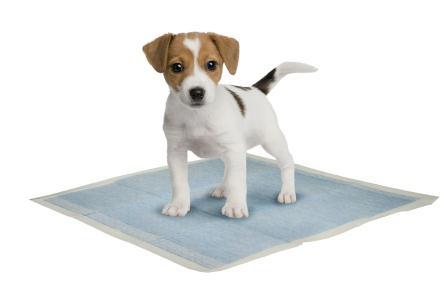HOUSEBREAKING YOUR PUPPY
Good housebreaking techniques teach your dog to relieve himself where and when you’d like him to. Dogs instinctively mark their own territory. Therefore, your goal is to teach your dog the boundaries of his territory. Housebreaking can be learned in four to eight weeks and can start when your puppy is eight weeks old.
WHAT YOU CAN DO
* First of all, buy a crate. Be sure it’s the right size: it should be large enough for comfort, but not too big because your puppy will sleep at one end and use the other end for his business. If you get an airline-approved crate, you can also use it like a mobile home when you’re traveling. You might be able to find a crate with an adjustable divider and slide the divider back as your puppy grows.
* Puppies need to go outside when they wake up, after every meal, and before bedtime. Most puppies eliminate within the first hour after eating. They should be fed two to three times each day, at the same time. Food should be left out for 20 to 30 minutes, and the last meal should be finished five hours before bedtime.
* Take your puppy out on a leash through the same door to the same spot every time, and when he does his business, reward him with praise. If your puppy does not eliminate when you take him outside, bring him inside, put him in his crate for 15 minutes, and repeat the procedure until you achieve success. At that point, when you bring him in don’t put him back in his crate. Confine your puppy to a relatively small, safe area of your home and provide constant supervision until your puppy is completely housetrained.
* If you have to leave your puppy at home alone each day for several hours, restrict him to a larger area like a small room or a playpen. This area should provide enough space for sleeping and eating. Several feet away, place papers at the elimination site.
* A common mistake is to let your dog go outside alone. Many dogs come back inside the house and the do their business. This causes most people to become upset. Their reaction inadvertently reinforces the negative behavior. If your dog relieves himself in front of you, softly tell a shy dog “no”, or use a firmer tone with a stubborn dog. Then take him to the spot on a leash where he is supposed to relieve himself and offer him immediate praise. Correcting your dog after the fact – even if it only happened a few minutes before – is ineffective because dogs have no way of associating your discipline with a past behavior.
* If your puppy does make a mistake inside, it’s important to get rid of the odor. Effective products are available commercially and can be recommended by your vet. Using ammonia to clean up a mistake can actually make it worse. With dedication, supervision and patience housetraining your puppy will be a success.
CANINE COGNITIVE DYSFUNCTION
* A lapse in housetraining can occur later in life. Canine cognitive dysfunction syndrome (CDS) is the equivalent of Alzheimer’s disease in humans. It is the third leading cause of euthanasia, and affects over seven million dogs ten years of age and older. It is an age-related deterioration of cognitive abilities characterized by behavioral changes that include loss of housetraining, disorientation, aimless wandering, staring into space, decreased responsiveness to family members, confusion and excessive sleeping.
* There is no blood test or CAT-scan to test for cognitive dysfunction; the evidence can only be found by examining the brain post mortem. Vets make the diagnosis by ruling out other problems that cause similar symptoms. Anipryl is a once-a-day pill that has shown significant results: over 77 percent of dogs show marked improvement in less than 30 days with this new medication.
WARNING
Worm puppies and adult dogs regularly. Some worms can be spread to people, especially children. The eggs are microscopic and are eliminated in the feces.
